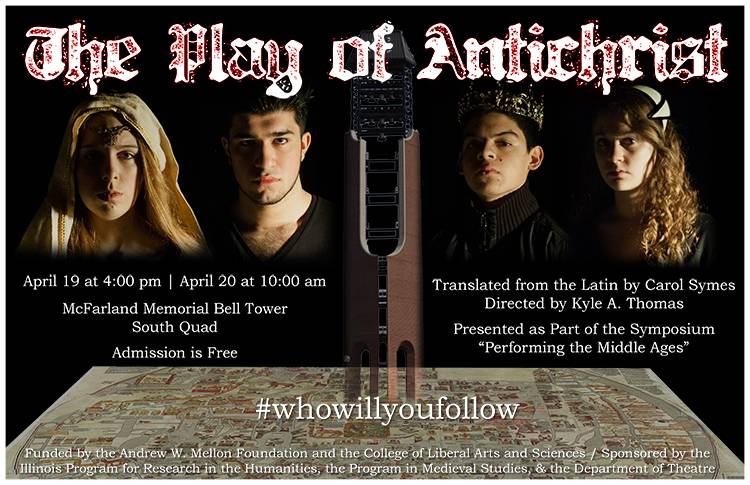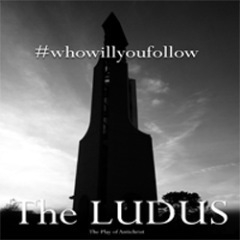Since joining Smile Politely as an Arts Editor some months ago, I’ve had a lot of press releases show up in my inbox. They all sound interesting. They all deserve coverage of some kind, and one does one’s very best to give all artists their due. Occasionally, though, something jumps off the screen. Occasionally, something is being announced to which attention must be paid.
Consider the following, from a very recent University of Illinois press release:
How do you make a play written almost 900 years ago, during the turbulent Middle Ages, relevant for today’s actors and a modern audience? Beyond its relevancy, can a medieval play that contains historical viewpoints and controversial opinions engage audiences, keeping them entertained as well as informed? That is the challenge for director Kyle A. Thomas, a PhD student in Theatre, and his cast and crew who will be performing The Play of Antichrist on April 19th and 20th at the McFarland Memorial Bell Tower on the south quad of the University of Illinois.
I had the privilege of working a bit with director Kyle A. Thomas during my stint with Inner Voices Social Issues Theatre group at the U of I, and it was clear right off the bat that he is a sharp, engaged, energetic fellow. I learned a little of his love for medieval literature and theatre during that time, and I am thrilled to see that he is involved in another grand theatrical adventure.
I had the pleasure of getting some information about this show from Thomas himself, and he was, as usual, sharp, engaged, and nothing if not energetic.
~~~~~~
Smile Politely: First off, could you give me a sense of your history with medieval plays? When did this become your field, and what led you to it?
Kyle Thomas: I’ve always loved history. I think the first time I seriously gained a particular interest in medieval theatre was during my theatre history course in undergrad. I felt that this was a ‘black hole’ of sorts in the history of theatre and  performance because there is so much information about the theatrical practices of the Greeks and the Romans to about the fifth century, and by the sixteenth century there ‘reappears’ another wealth of information. By the time I started grad school I knew that I wanted to focus on the European theatre of the Middle Ages and help to fill the knowledge gap that has so long existed in this area of theatre as well as work to change the perception of the medieval plays we do know about. Also, I should mention that working with Dr. Carol Symes as my advisor has opened up many opportunities to explore this area of theatre history. She translated the three medieval plays that I’ve directed while here at Illinois. She’s an incredible historian and has worked professionally in theatre as well, which gives her particular insight into staging while she is translating the plays.
performance because there is so much information about the theatrical practices of the Greeks and the Romans to about the fifth century, and by the sixteenth century there ‘reappears’ another wealth of information. By the time I started grad school I knew that I wanted to focus on the European theatre of the Middle Ages and help to fill the knowledge gap that has so long existed in this area of theatre as well as work to change the perception of the medieval plays we do know about. Also, I should mention that working with Dr. Carol Symes as my advisor has opened up many opportunities to explore this area of theatre history. She translated the three medieval plays that I’ve directed while here at Illinois. She’s an incredible historian and has worked professionally in theatre as well, which gives her particular insight into staging while she is translating the plays.
SP: What other plays of this type have you produced, participated in, or directed?
Thomas: When I was in undergrad I played the character of Fellowship in the medieval play Everyman. Last year I directed staged readings at the Spurlock Museum of The Play of Adam and Babio, two twelfth-century plays. Those two plays served as springboards for my current work with Play of Antichrist.
SP: On the off-chance that Smile Politely readers aren’t familiar with medieval drama, could you summarize the plot for us?
Thomas: While on its face it may strike someone as highly religious — it is, after all, about the Antichrist — it is tied more into politics and the concept of power: who has power, who doesn’t, by what means does one attain it? Power politics and spirituality are two concepts that are more separate today, but they went hand in hand in the Middle Ages. This is a play that explores the use of power in the political and spiritual spheres.
The play can be broken into two sections. The first section deals with the Emperor (here understood to be the Holy Roman Emperor and likely a representation of the play’s contemporary Emperor Frederick I “Barbarossa”) as he conquers or subdues the kingdoms of the world. Once he has completed this task, he gives his imperial crown over to God in the Temple in Jerusalem. This brings about the second section of the play where Antichrist enters and, with the help of the allegorical figures Hypocrisy and Heresy, also begins to take over the kingdoms of the world. Once he has done this and holds all worldly power, he attempts to take over the spiritual power of the world by convincing Synagoga, the allegorical representation of the Jewish people, that he is the true Messiah. Although initially deceived, she is convinced by Enoch and Elijah to reject Antichrist and is martyred for doing so. In the end, the Antichrist calls together all people to come worship him, but before he is able to complete this, something happens–the original manuscript calls for a loud noise or crash calling to mind the Greek deus ex machina–which kills Antichrist and the play ends.

SP: The press release for this event states that there are relevant connections between this 12th-century play and 21st-century life. Without delving into spoilers, could you elaborate?
Thomas: One main thing that I keep telling my actors and production team is that theatre and plays were the original social media. For centuries, playwrights used the dramatic form to explore current events, criticize their leaders, pose hypothetical situations, and generally communicate with the widest possible audience. Antichrist is an excellent example of this. When the play was written (1160), tensions from the Investiture Controversy were still boiling between the Holy Roman Emperor and the Papacy, and this play is entering directly into that debate on the side of the Holy Roman Emperor Frederick I “Barbarossa.”
Because of the social media aspect inherent within the play, several of the actors will actually be using Twitter and Facebook during the performance. We will be  encouraging the audience (both in attendance and in absentia) to follow the hashtag #whowillyoufollow during the performance to get a very unique view of the show. We’re expanding the idea of audience, and one can be actively involved in the multiple ways in which we disseminate the experience of the play. This ties into a directing methodology I’m working on that I call ‘contextual layering’ which maintains that the performers are ‘layering’ a 21st-century context upon the context imbued within the play. In essence, we make no attempt at recreating a medieval play in the way it would have been done in the twelfth century. We follow the script as closely as possible, treating it as a historical artifact, but the performance is a contemporary layer that provides a new point of interest into the material and themes the play explores.
encouraging the audience (both in attendance and in absentia) to follow the hashtag #whowillyoufollow during the performance to get a very unique view of the show. We’re expanding the idea of audience, and one can be actively involved in the multiple ways in which we disseminate the experience of the play. This ties into a directing methodology I’m working on that I call ‘contextual layering’ which maintains that the performers are ‘layering’ a 21st-century context upon the context imbued within the play. In essence, we make no attempt at recreating a medieval play in the way it would have been done in the twelfth century. We follow the script as closely as possible, treating it as a historical artifact, but the performance is a contemporary layer that provides a new point of interest into the material and themes the play explores.
SP: Despite all of the technological formats at our disposal today, it seems like it’s still hard to properly market plays. How do you sell this show? Assuming there isn’t a big middle ages market out there, what is the draw for C-U folks?
Thomas: This is the big question. I don’t know that I have the answer, but I’m definitely working hard to find it. When trying to advertise a show like Antichrist you immediately come up against the perceptions people often have of the Middle Ages or of medieval art: It’s preachy, too religious, ignorant, sub-standard, dark, socially and culturally backwards. While some of these labels aren’t always unwarranted, this way of thinking focuses too much on the past and not enough on what a medieval play can be today to a modern audience. For me, I’m not trying to provide a theme park experience where one can ‘step into the Middle Ages.’ Rather, I hope that we can use medieval plays as a way to explore problems and issues we deal with today — if a medieval play is particularly anti-Semitic, we can ask how things have changed today, how do we approach this, and how do we as a society form an opinion about this material – the history provides an aesthetic distance for us to approach these types of questions.
Marketing plays is really difficult, but one area that I feel very strongly about is the theatre’s reluctance to embrace social media and mobile technology. I know that my opinion on this often leaves me as the outsider, but if you plan to cultivate young audiences and then ask them to sit in the dark for two to three hours, completely disconnected from the world, then you have lost them forever. Theatre is not an escapist art; it is an engaging art. And many audiences today see themselves as a channel through which engagement occurs. They witness something and then they understand their responsibility is to mediate that through technology and personal experience. What better way to market your show than to let your audience do it for you?! While it’s happening! It’s often said that theatre’s greatest asset is that it is live, and we live in a world where immediacy is highly valued. Why not expand the idea of a live experience through the technological reach of your audience and their desire to share something unique as it happens?
~~~~~~
Why not indeed?
The Play of Antichrist runs two consecutive days, with performances on April 19 (at 4:00 p.m.) and April 20 (at 10:00 a.m.). One would have to consider this a rare opportunity to witness and be involved in an unusual and terribly interesting theatre experience. As Thomas himself stated, “Theatre is not an escapist art; it is an engaging art.”
You heard the man. Get out there and engage.
Performed as a part of the “Performing the Middle Ages” symposium hosted by the Program in Medieval Studies at the University of Illinois and funded in part by a planning grant from the Andrew W. Mellon Foundation. The Play of Antichrist is free and open to the public.








